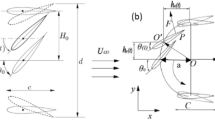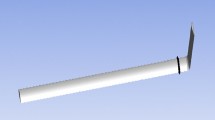Abstract
In designing the wings of UAVs, some factors such as the lift coefficient and lift-to-drag ratio (aerodynamic efficiency) play important roles in meeting the required fuel consumption, flight endurance, speed, reliability, maneuverability and runway length. One of the schemes presented for achieving the above objectives is the use of multi-element wings, in which high-lift mechanisms such as flaps and slats help the main airfoil. The recent advancements in the design of these mechanisms have made it possible to present a variety of morphing flap models that can perform adequately under different flight conditions. In the present research, a two-element wing model of a drone with medium-altitude and long-endurance capabilities and a morphing flap is numerically analyzed and the obtained results are compared with and validated by the empirical data obtained from wind tunnel tests. For optimizing the flap shape to achieve the maximum aerodynamic efficiency of the wing, the response surface method is used as a design of experiments technique. In this approach, several geometrical parameters that indicate the position and curvature of a flap were defined and different arrangements of these parameters are presented as experiment designs, then the aerodynamic efficiency of the wing for each design of experiment is determined numerically and the optimum design is proposed. The results show that the factors of flap curvature and vertical distance of flap to the main airfoil have a significant effect on the aerodynamic efficiency of the considered wing.











Similar content being viewed by others
References
Balaji R, Barmkamp F (2006) Effect of flap and slat riggings on 2-D high-lift aerodynamics. J Aircr 43:803–811
Gamboa P, Aleixo P, Suleman A (2007) Design and testing of a morphing wing for an experimental UAV. In: Platform innovations and system integration for unmanned air, land and sea vehicles (AVT-SCI Joint Symposium). Meeting proceedings RTO-MP-AVT-146, Paper 17. Neuilly-sur-Seine, France: RTO, pp. 17-1–17-30
Jeong S, Murayama M, Yamamoto K (2005) Efficient optimization design method using kriging model. J Aircr 42:56–62
Kanazaki M, Tanaka K (2006) Multi-objective aerodynamic optimization of elements setting for high-lift airfoil using kriging model, 44th AIAA aerospace sciences meeting and exhibit, Nevada
Kays W, Crawford M, Weigand B (2012) Convective heat and mass transfer, 4th edn
Kim S, Alonsoy J, Jamesonz A (2002) Design optimization of high–lift configurations using a viscous continuous adjoint method. AIAA J 38:675–682
Landman D, Britcher P (2000) Experimental geometry optimization techniques for multi-element airfoils. J Aircr 37:707–711
Matteo N, Guo S, Ahmed S, Li D (2010) Design and analysis of a morphing flap structure for high lift wing, 51st.AIAA/ASME/ASCE/AHS/ASC structures, structural dynamics, and materials conference, Nevada
Monotgormery D (2008) Design and analysis of experimental. Wiley, New York
Myers R, Monotgormery D (2002) Response surface methodology. Wiley, New York
Nagel A (2013) Wings for UAV based on high-lift airfoils, Aero India 2013 International Seminar Bangalore, India, 04–06 February 2013
Naveen KM, Muddkavi Y (2010) CFD Analysis of multi-element aerofoils using OPENFOAM. Proceedings of the 37th National and 4th international conference on fluid mechanics and fluid power. December 16–18, 2010, IIT Madras, Chennai, India
Rogers E (1994) A comparison of turbulence models in computing multi-element airfoil flows. AIAA Paper 32:324–330
Ross T, Crossley W (2000) Method to assess commercial aircraft technologies. J Aircr 37:570–576
Sadafi MH, Hosseini R, Safikhani H, Bagheri A, Mahmoodabadi MJ (2011) Multi-objective optimization of solar thermal energy storage using hybrid of particle swarm optimization, multiple crossover and mutation operator. IJE B 24:367–376
Safikhani H, Eiamsa-ard S (2016) Pareto based multi-objective optimization of turbulent heat transfer flow in helically corrugated tubes. Appl Therm Eng 95:275–280
Safikhani H, Abbassi A, Khalkhali A, Kalteh M (2014) Multi-objective optimization of nanofluid flow in flat tubes using CFD, artificial neural networks and genetic algorithms. Adv Powder Technol 25(5):1608–1617
Sateesh M, Raja Dhas JE (2013) Multi objective optimization of flux cored ARC weld parameters using fuzzy based desirability function. IJST, Transactions of Mechanical Engineering, vol 37, No M2, Printed in The Islamic Republic of Iran, pp. 175–187 (2013)
Secanell M, Suleman A, Gamboa P (2006) Design of a morphing airfoil using aerodynamic shape optimization. AIAA J 44:247–253
Shepshelovich M (2009) The progress in development of UAV wings. ICAUV, India
Shepshelovich M, Nagel A (2012) Slotted high lift aerofoils, Patent No.: US 8,109,473 B2
Simpson T, Mauery T, Korte J, Mistree F (1998) Comparison of response surface and kriging models for multidisciplinary design optimization. AIAA, Reston
Spalart P, Allmaras S (1992) A one-equation turbulence model for aerodynamic flows, Technical Report AIAA-92-0439, American Institute of Aeronautics and Astronautics
Steinbuch M, Marcus B, Shepshelovich M (2003) Development of UAV Wings Subsonic Designs, 41st aerospace sciences meeting and exhibit, Nevada
Tavasoli A, Naraghi M (2013) An optimized multi-stage scheme to coordinate steering and braking, IJST, Transactions of Mechanical Engineering, Vol. 37, No. M2, Printed in The Islamic Republic of Iran, 161–174
Trapani G, Kipourosy T, Savill M (2010) Computational aerodynamic design for 2D high-lift airfoil configurations, Sixth Pegasus-AIAA Student Conference, Sevilla (Spain)
Vavalle A, Qin N (2007) Iterative response surface based optimization scheme for transonic airfoil design. J Aircr 44:365–371
Xiong-feng Z, Zhong-xi H, Zheng G, Zhao-Wei L (2012) Dynamic mesh based airfoil design optimization. World Acad Sci Eng Technol 69:692–697
Author information
Authors and Affiliations
Corresponding author
Rights and permissions
About this article
Cite this article
Manshadi, M.D., Jamalinasab, M. Optimizing a Two-Element Wing Model with Morphing Flap by Means of the Response Surface Method. Iran J Sci Technol Trans Mech Eng 41, 343–352 (2017). https://doi.org/10.1007/s40997-016-0067-8
Received:
Accepted:
Published:
Issue Date:
DOI: https://doi.org/10.1007/s40997-016-0067-8




